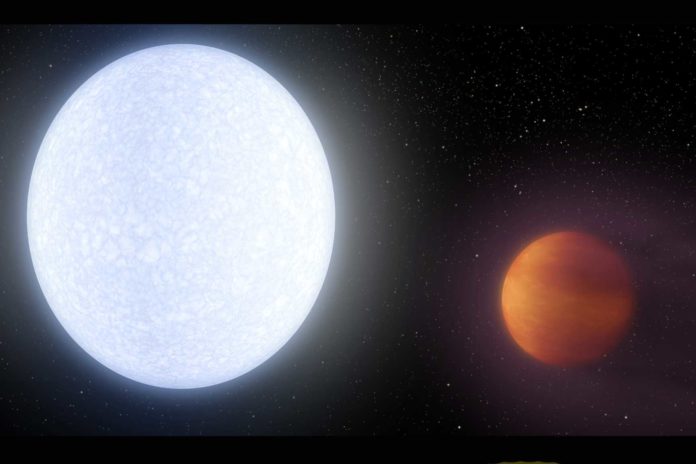NASA’s JPL scientists are recreating conditions that found in the atmospheres of a special class of exoplanets called ‘hot Jupiters’ using a high-temperature “oven” to heat a mixture of hydrogen and carbon monoxide to more than 2,000 degrees Fahrenheit (1,100 Celsius), about the temperature of molten lava.
Hot Jupiters are gas giant planets with an orbital period of fewer than 10 days. The short period means that hot Jupiters are very close to their host stars. Their close proximity to a star means their temperatures can range from 1,000 to 5,000 degrees Fahrenheit (530 to 2,800 degrees Celsius) or even hotter.
However, it is quite impossible to precisely recreate the same environment, but scientists can only try.
Scientists began with a simple chemical mixture of hydrogen gas and 0.3 percent carbon monoxide gas. Both molecules are commonly detected in the universe and early galaxies, and they could sensibly make the air out of a hot Jupiter. At that point, the group warmed the blend to somewhere in the range of 620 and 2,240 degrees Fahrenheit (330 and 1,230 Celsius).
The group likewise uncovered the lab blend to a high dose of ultraviolet radiation – like what a hot Jupiter would experience circling so near its parent star. The UV light ended up being a potent ingredient. It was generally in charge of a portion of the examination’s more amazing outcomes about the science that may happen in these toasty environments.
Hot Jupiters are expansive via planet gauges, and they emanate lighter than cooler planets. Such factors have enabled space experts to accumulate more data about their environments than most different sorts of exoplanets. Those perceptions uncover that numerous hot Jupiter environments are opaque at high heights. Despite the fact that mists may clarify the haziness, they turn out to be less and less practical as the weight diminishes, and the obscurity has been seen where the atmospheric pressure is low.
Scientists have been looking for potential explanations other than clouds, and aerosols – solid particles suspended in the atmosphere – could be one. However, according to the JPL researchers, scientists were previously unaware of how aerosols might develop in hot Jupiter atmospheres. In the new experiment, adding UV light to the hot chemical mix did the trick.
Benjamin Fleury, a JPL research scientist and lead author of the study said, “This result changes the way we interpret those hazy hot Jupiter atmospheres. Going forward, we want to study the properties of these aerosols. We want to better understand how they form, how they absorb light and how they respond to changes in the environment. All that information can help astronomers understand what they’re seeing when they observe these planets.”
The study surprised scientists in another way also: The chemical reactions delivered a significant amount of carbon dioxide and water. While water vapor has been found in hot Jupiter environments, researchers generally anticipate that this precious molecule should shape just when there is more oxygen than carbon.
The new examination demonstrates that water can frame when carbon and oxygen are available in equivalent sums. (Carbon monoxide contains one carbon particle and one oxygen iota.) And while some carbon dioxide (one carbon and two oxygen molecules) framed without the expansion of UV radiation, the reactions quickened with the expansion of recreated starlight.
JPL exoplanet scientist Mark Swain, a study co-author said, “These new results are immediately useful for interpreting what we see in hot Jupiter atmospheres. We’ve assumed that temperature dominates the chemistry in these atmospheres, but this shows we need to look at how radiation plays a role.”
With next-generation tools like NASA‘s James Webb Space Telescope, set to launch in 2021, scientists might produce the first detailed chemical profiles of exoplanet atmospheres, and it’s possible that some of those first subjects will be hot Jupiters. These studies will help scientists learn how other solar systems form and how similar or different they are to our own.
